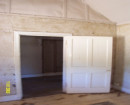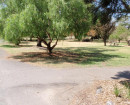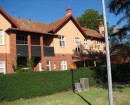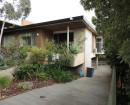ICI Residential Precinct
Station Road and Ballarat Road and Hyde Street and Hume Street DEER PARK, Brimbank City
-
Add to tour
You must log in to do that.
-
Share
-
Shortlist place
You must log in to do that.
- Download report
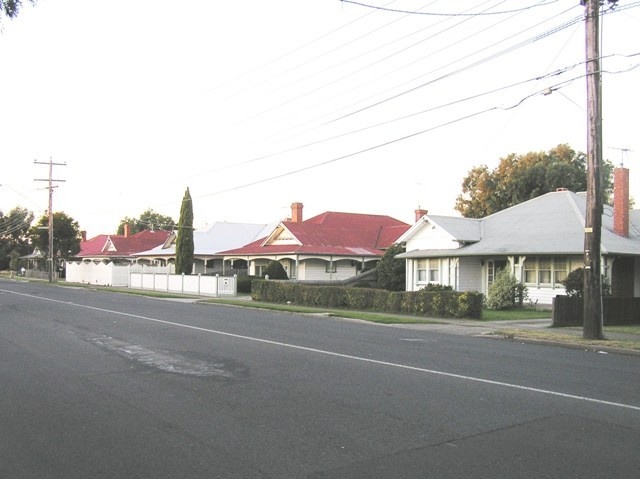

Statement of Significance
Statement of Significance
The ICI Residential Heritage Area is of State historical and architectural significance as a rare and distinctive company township and for its association with the nineteenth century origins and twentieth century expansion of the former Nobel (later ICIANZ, now ORICA) factory which became the major private manufacturer of explosives and munitions in Australia.
The estate, initiated by Leathercloth Pty. Ltd., (a subsidiary of Nobel) is one of a number of company sponsored housing schemes in the Brimbank municipality and reflects a pattern of development where nationally important industries established in green-fields sites beyond the urban fringe and so needed to provide accommodation and other facilities for workers. The inclusion of the recreation reserve in the precinct and the adjacent separately listed Deer Park Hall, and Hunt Club Hotel (a former ICI training centre) further demonstrate the company role in local planning and development.
The precinct is significant for its association with the largest explosives, chemicals and plastics manufacturer in Australia, originally established here under the importer Jones Scott and Co in the 19th century, and then becoming the Australian Lithofracteur Company (Krebs Patent), a rival to Nobel's dynamite patent, and in production in Australia only a couple of years after Nobel's Ardeer factory was opened. It later merged with the Nobel company and then became ICIANZ before the most recent change to ORICA.
This important industry played a major role in mining through the development of progressively more efficient and safer explosives. It also contributed to wartime production in ammunition, initiators and in World War Two, the development of synthetic ammonia production and construction of the Defence Explosives Annexe No 5 (later the Albion Explosives Factory). The Leathercloth plant was influential in the development of synthetic materials for the motor industry including vinyl seat fabrics and hoods, and has continued to play an important role in synthetic fabrics.
The houses in Station Road, Ballarat Road, Hume Street and Hyde Street reflect a sequence of development in their distinctive styles and forms, reflecting the colonial origins of the company in their Indian Bungalow forms as well as giving insight to the social and economic status of their proposed occupants with the larger and more elaborate houses intended for factory managers. The inclusion of concrete houses in the estate also points to the innovation in building in the later period, possibly as a response to war-time material shortages.
The recreation reserve and contemporary (but altered) pavilion are significant in demonstrating the role of the company in providing community services to their workers, and as evidence of the urban design and landscape approaches to company housing in the period.-
-
ICI Residential Precinct - Physical Description 1
Description
This heritage area includes the ICI housing scheme of the late 1920s-1940s in Ballarat Road, Station Road, Hume Street and Hyde Street. This housing scheme centred on a group of streets formed near the corner of Ballarat Road and Station Road and comprised houses of three distinct styles.
These are:
Brick Californian Bungalow style: 789, 791, 793 (altered), 795 Ballarat Road. Red brick, with verandahs across part of the front, featuring more complex roof forms with gable and hipped sections. These houses were constructed between 1928 and 1935.
Indian Bungalow style: at 76-58 Station Road, 4-12 Hyde Street: These include wide timber verandahs following the roof line and returning a short distance down one side. Red brickchimneys feature corbelled tops on the earlier houses (62-76 Station Road). These houses were constructed between 1928 and 1939, in four groups: 62-68 Station Road (1928-30); 70-76
Station Road (1930-34); 58-60 Station Road and 4-6 & 10 Hyde Street (1934-35); and 12
Hyde Street (1938-39).
Interwar bungalows and Old English houses: 787 Ballarat Road and 5-7 Hume Street are classic 1930s hipped-roof brick bungalows with face brick or a rendered finish. 785 Ballarat Road and 3 Hume Street are rendered, hipped-roof houses with a dominant front chimney and eaves-less front gable. They were constructed between 1939 and 1942.
Cottage style: 16, 20-24 Hyde Street and 52-56 Station Road (altered), relatively small concrete-walled houses with asymmetrically facades, small verandah/porch over the entrance and tapered chimneys. The major and minor front gables are filled with pressed-metal panels in a shingle pattern. The roofs appear to be of pressed-metal 'tiles'. They had timber double-hung sash windows, but most have been replaced with aluminium units. These houses were constructed between 1945 and 1949.
The principal alterations have been made to the verandahs, with one partly bricked in with an arched colonnade. Others have had windows replaced or new openings made. The Ballarat Road houses include one relatively unaltered (No. 789) which features stained shingles, wire fabric front fence and some remnant garden planting. The house at No. 787 also retains its wire fence. The house at 797 Ballarat Road has had its facade completely reconstructed in cream bricks in an unsympathetic style, and is considered non-contributory to the precinct.
A corner site at Ballarat and Hume Street comprises a maternal and child health centre of later c.1960 date, but evidently on land reserved for community use in the original subdivision.
The surviving houses that are contributory to the precinct include the following:
ADDRESS, PLACE, DATE, Significance Level
785 Ballarat Road, ICI House, Rendered Old English house, 1940-42, Contributory,
787 Ballarat Road, ICI House, Brick Bungalow, 1940, Contributory,
789 Ballarat Road, ICI House, Brick Californian Bungalow, 1928-30, Contributory,
791 Ballarat Road, ICI House, Brick Californian Bungalow, 1930-34, Contributory,
793 Ballarat Road, ICI House, Brick Californian Bungalow, 1930-34, Contributory,
795 Ballarat Road, ICI House, Brick Californian Bungalow, 1934-35, Contributory,
Hume Street, Deer Park cricket ground pavilion and recreation reserve, 1934-35,
Contributory,
3 Hume Street, Rendered Old English house, 1939-40, Contributory,
5 Hume Street, red brick Bungalow, 1939-40, Contributory,
7 Hume Street, rendered Bungalow, 1939-40, Contributory,
4 Hyde Street, timber Indian Bungalow, 1934-35, Contributory,
6 Hyde Street, timber Indian Bungalow, 1934-35, Contributory,
10 Hyde Street, timber Indian Bungalow,1934-35, Contributory,
12 Hyde Street, timber Indian Bungalow, 1938-39, Contributory,
16 Hyde Street, Cottage style, concrete, 1945-49, Contributory,
20 Hyde Street, Cottage style, concrete, 1945-49, Contributory,
22 Hyde Street, Cottage style, concrete, 1945-49, Contributory,
24 Hyde Street, Cottage style, concrete, 1945-49, Contributory,
52 Station Road, Cottage style, concrete, 1945-49, Contributory,
54 Station Road, Cottage style, concrete, 1945-49, Contributory,
56 Station Road, altered Cottage style, concrete, 1945-49, Contributory,
58 Station Road, timber Indian Bungalow, 1934-35, Contributory,
60 Station Road, timber Indian Bungalow, 1934-35, Contributory,
62 Station Road, timber Indian Bungalow, 1928-30, Contributory,
64 Station Road, timber Indian Bungalow, 1928-30, Contributory,
66 Station Road, timber Indian Bungalow, 1928-30, Contributory, 68 Station Road, timber Indian Bungalow, 1928-30, Contributory,
70 Station Road, timber Indian Bungalow, 1930-34, Contributory,
72 Station Road, timber Indian Bungalow, 1930-34, Contributory,
74 Station Road, timber Indian Bungalow, 1930-34, Contributory,
76 Station Road, timber Indian Bungalow, 1930-34, Contributory,
A number of places were identified in the original survey as of potential significance but were
not deemed to be contributory to the significance of the precinct. These are later houses which
while continuing a connection with the ICI factory and its employees, do not exhibit the same
period or style of the contributory buildings. The places are:
ADDRESS, PLACE, DATE, Significance Level
1 Hume Street, house, brick veneer, 1960s, Typical
2 Hume Street, house, cream brick veneer, 1960s, Typical
9 Hume Street, brick veneer Bungalow style, 1950s, Typical
11 Hume Street, brick veneer Bungalow style, 1950s, Typical
799 Ballarat Road, Kindergarten, Cream brick modernist structure, 1960s, Typical
797 Ballarat Road, ICI House Brick Californian Bungalow, 1934-35, Typical, heavily altered
front
Several places associated with the Orica Factory or adjacent to the heritage precinct have also
been identified in the heritage study, but have not been included in the present precinct. These
include:
ADDRESS, PLACE, DATE, Significance Level, Site No.
Ballarat Road, Braybrook Shire Hall site, 1885, Individually listed archaeological, 127
Ballarat Road, ICI Explosives Laboratory, 1875, Individually listed State, 007
Ballarat Road, ICI Explosives complex (now ORICA), 1875, Individually listed State, 006
Station Road, ICI Leathercloth Factory, 1920, Individually listed State, 009
50 Station Road, Deer Park Hall, 1935, Individually listed Local, 083
775 Ballarat Road, Hunt Club Hotel, 1886/1920s?, Individually listed Local, 076
Ballarat Road, Former ICI Gatehouse, 1920s
761 Ballarat Road, former House ICI manager, 1925c
757 Ballarat Road, former House ICI manager, 1925c
Ballarat Road, former ICI - Federal Fertilisers, 1897
Ballarat Road, former I.C.I. Ammonia Plant, 1940 c.
A number of places, which formerly contributed to the historical significance of the precinct,
have been demolished in the last decade or so. These include the following:
ADDRESS, PLACE DATE
8 Hyde Street, demolished former Indian Bungalow.
14 Hyde Street, demolished former concrete house, now modern brick veneer, 1980s
18 Hyde Street, demolished former concrete house, current house 1980s
78 Station Road, vacant site
ICI Residential Precinct - Physical Conditions
Condition/Integrity
Most of the original houses in the residential component of the precinct are intact, with recent evidence of sympathetic restoration. In some cases there has been a lack of understanding of the original period of construction of houses, and a misguided attempt to 'Victorianise' them, see in particular the 1940s concrete cottage at 56 Station Road. In addition, a number of houses have had the original timber windows replaced with aluminium units, particularly the concrete cottages.
ICI Residential Precinct - Historical Australian Themes
4 Building settlement, towns and cities
4.1 Planning urban settlementsICI Residential Precinct - Intactness
Substantially intact.
Heritage Study and Grading
Brimbank - Brimbank City Council Post-contact Cultural Heritage Study
Author: G. Vines
Year: 2000
Grading: StateBrimbank - Melbourne Western Region Industrial Heritage Study
Author: G. Vines & A. Ward
Year: 1989
Grading:
-
-
-
-
-
BLACK POWDER MILL
 Victorian Heritage Register H2029
Victorian Heritage Register H2029 -
ICI Housing Estate Precinct
 Brimbank City
Brimbank City -
Mount Derrimut Homestead
 National Trust
National Trust
-
'ELAINE'
 Boroondara City
Boroondara City -
-oonah
 Yarra City
Yarra City -
..eld House
 Yarra City
Yarra City
-
-






